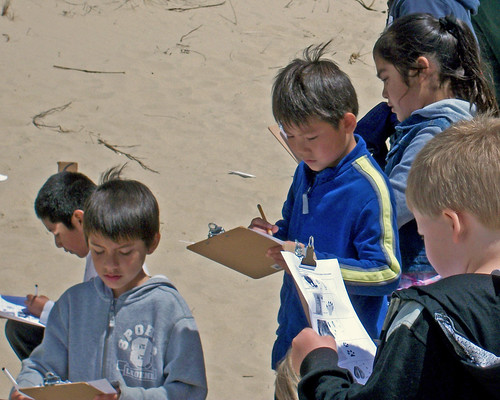Most people wouldn’t associate sand dunes with a forest, but on the central Oregon Coast, the Siuslaw National Forest is home for the Oregon Dunes National Recreation Area – 40 miles of wind-sculpted, shifting sands towering up to 500 feet above sea level.
Formed by the ancient forces of wind, water and time, these dunes are like no others in the world. This is the largest expanse of coastal sand dunes in North America and they provide numerous recreational opportunities with thick “tree islands,” open dunes, marsh-like deflation plains and beaches.
Siuslaw Elementary School second graders recently charged onto the rolling sand slopes of the dunes for a day of inspired learning and exploration with Siuslaw National Forest field rangers. Four classes participated, with more than 100 students, teachers and parent chaperones.
“For some students, today was one of their first in-depth experiences in the coastal dunes, and will be remembered as one of the highlights of their school year,” noted Gerry Fleming, second grade teacher and event organizer. “It was an amazing day—this program gets better every year,” Fleming added. “It’s incredible the kind of connections these kids make to what they’re seeing and learning.”

Through hands-on experiments, students learned the story of the dune geology and about the elemental forces that continue to shape this dynamic landscape. Students also identified animal tracks in the sand and learned about the variety of unique habitats the dunes provide. Another station introduced the plight of the snowy plover, a federally protected shorebird which nests on the open sand. While frolicking up the sand to their last station, kids looked up to see a bald eagle soar overhead from its perch in a forest island.
This marked the fourth year of this annual field trip, which is based on a partnership between the school and the forest. Students had already received in-school presentations, which were prepared and presented by local author, dunes expert, and Siuslaw National Forest volunteer, Dina Pavlis who also staffed the outdoor geology station. The field trip was also made possible by summer field rangers, through the Forest Service Valuing People and Places program.
Beyond education, the goal of the program is to leave a lasting impression. When kids are inspired they will remember and they will become the future stewards of these places. Students who participated in the field trip two years ago as second graders returned this year, as fourth-graders, to do invasive species work.
The second graders learned about the greatest threat to the long-term survival of the dunes: European Beach grass. This invasive grass was planted through the 20th century to stabilize the shifting sand, and has now altered the intricate balance of interaction which has sustained the dunes for millennia. Students were eager to hear about innovative strategies the Forest Service and partner organizations use to mitigate the threat of invasive plants.
“The dunes won’t disappear,” said one determined student after the event. “I’m going to save them.”

